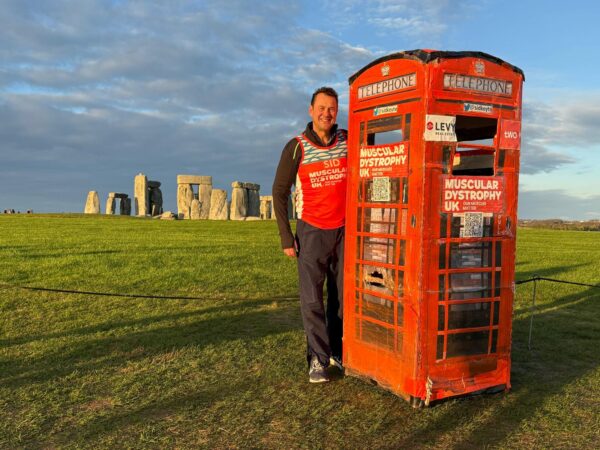Our condition-specific alert cards provide crucial information for emergency healthcare professionals treating patients with muscle wasting conditions.
Paediatric-onset myotonic dystrophy type 1
Paediatric-onset myotonic dystrophy type 1 (DM1) includes congenital myotonic dystrophy (CDM) and childhood-onset DM1. Both forms of DM1 affect children under the age of 18.
In CDM, symptoms appear at birth, or within the first month of life. There can be life-threatening complications, especially in the first year. With neonatal intensive care, some babies improve and may increase their muscle strength over time.
In childhood-onset DM1, symptoms start during childhood. There are no symptoms at birth or within the first month of life.
Diagnosing paediatric-onset DM1 can be difficult and can take a long time. You can read about how the condition is usually diagnosed here.
Symptoms can vary depending on age. Generally, the earlier symptoms appear, the more severe they will be. Symptoms can affect several areas of the body.
Skeletal muscles
Skeletal muscles control how bones and joints move. Paediatric-onset DM1 can cause weakness in skeletal muscles.
Babies with CDM may appear ‘floppy’ at birth and have limited movement. This is called hypotonia. They often take longer to reach motor milestones, such as sitting up by themselves, but most will learn to walk by themselves. Movement usually gets better during early childhood and can continue to improve up until puberty. It’s important for children to be physically active to help with this.
Children with childhood-onset DM1 may have some muscle weakness in the legs and hands. They can also take longer to learn whole-body movements, such as jumping and lifting.
Weak muscles in the face can affect expression, speech, swallowing, and eyesight. Speech and language therapy can help with speech and swallowing. Older children may need support at school, college, or work. Possible eye problems include droopy eyelids (ptosis) and not being able to fully close the eyelids.
Some older children may find their muscles become stiff and slow to relax. For example, when gripping something, it can take a few seconds for them to let go. This is called myotonia. It can also affect the muscles involved in speech, swallowing, and digestion. There are medicines to treat myotonia. Keeping warm and gently exercising the muscles can also help.
Skeletal
Many children with CDM have problems affecting the skeleton, such as club foot (talipes). This is where one or both feet turn in and under the ankle. They may also develop a curve in the spine (scoliosis) and stiff joints (contractures).
Treatment options include gentle stretches, bracing, or surgery.
Respiratory
Weakness in the muscles that help you breathe can lead to breathing problems. In severe cases, this could lead to respiratory failure. This is where the lungs do not take in enough oxygen or remove enough carbon dioxide.
More than half of babies with CDM may have breathing problems at birth. They may need help to breathe, using a machine called a ventilator. Respiratory failure can be a major cause of serious illness in newborns.
Breathing problems are less common and milder in childhood-onset DM1. But this can vary from person to person. Some children may develop more severe symptoms.
Weakness in the breathing and face muscles can affect the ability to cough and swallow. This can lead to accidentally breathing in food or drink (aspiration). It can also cause chest infections. Tests and treatment can help to manage symptoms and prevent infections. It’s important that children are up to date with their vaccinations to protect them against preventable diseases.
Breathing problems can lead to sleepiness during the day. This is called excessive daytime sleepiness (EDS). Symptoms may start during the teenage years and may get worse over time. Children may struggle to stay awake or pay attention during school. Some children may need support from a special education needs co-ordinator (SENCO).
Cardiovascular
The cardiovascular system includes the heart, blood vessels, and blood. Children with DM1 are less likely than adults to have heart problems. But it’s important to report any of the following symptoms to doctors straight away, so that they can investigate:
- Heart palpitations – feeling like the heart is racing, pounding, or beating irregularly
- Fainting or feeling faint
- Shortness of breath
- Chest pain
- Severe tiredness with no clear cause
All children with DM1 should have a yearly heart test, called an electrocardiogram (ECG). If the ECG shows a problem with the heart, children should see a cardiologist. Treatment options may include a pacemaker to help the heart beat regularly.
Gastrointestinal and urinary
Gastrointestinal problems affect the digestive system. They’re common in paediatric-onset DM1.
Facial weakness can make it difficult for children to swallow, so they may need to have a feeding tube. Swallowing and feeding problems often improve with age, and with the help of a speech and language therapist. Some children may continue to have some feeding problems.
Children and adults may have digestion problems, such as:
- Pain and bloating in the stomach area (abdomen)
- Hard, dry poo that’s difficult to pass (constipation) – this may lead to a build-up of poo in the back passage and an enlarged bowel
- Loose, runny poo (diarrhoea)
- Loss of bowel control (incontinence)
- Aspiration – this is when food or drink goes into the airway and lungs
Some children may not be able to control their bladder. Potty or toilet training may be difficult. This can get better with age.
A doctor may recommend treatments such as fibre supplements or medicines that help pass poo (laxatives).
Learning and behaviour
Children with DM1 may have problems with learning and behaviour.
Learning disabilities and speech problems are common in children with CDM. Learning disabilities may involve problems with daily activities, learning, and thinking. This can affect their independence.
In childhood-onset DM1, learning disabilities are generally less severe. They may involve problems with understanding and processing information.
In both CDM and childhood-onset DM1, children may have communication or behaviour problems. For example, autism or attention deficit disorder.
Older children may find it difficult to pay attention at school, due to tiredness and sleepiness. They may also have problems joining in and making friends if they have speech problems.
Getting the right support can help children with DM1 have a good quality of life. For example, speech and language therapy can help with communication and swallowing problems. Children may need extra support at school or college (SENCO). Or they may go to a school for children with special educational needs. If your child needs extra support, speak to their school or local authority.
Genetic changes
CDM and childhood-onset DM1 are caused by a change in the DMPK gene. This change leads to an abnormal increase in a repeated section of genetic code, known as CTG repeats. When the CTG repeats get too high, it disrupts how the cells work and causes muscle weakness and other symptoms. More repeats generally result in more severe symptoms.
The number of CTG repeats can increase when the gene is passed from parent to child. This means that a child may have more severe symptoms than their parent. This is called anticipation. In some cases, the parent may not have noticeable symptoms.
Speak to your neuromuscular team or GP if you’re worried about myotonic dystrophy in a current or future pregnancy. They may refer you for genetic counselling and testing. If you have DM1 and you’re planning a pregnancy, you may want to ask about prenatal diagnosis.
Inheritance
CDM and childhood-onset DM1 are inherited in an autosomal dominant pattern. This means that a child only needs to inherit the changed gene from one parent to have the condition. A child has a 1 in 2 chance of having the condition if one of their parents has the changed gene. It’s usually inherited from an affected mother. Inheritance from an affected father is rare but it does happen sometimes and should not be excluded.
For more information, see our inheritance and genetics page.
The doctor will refer a child for tests if they show symptoms of DM1, or if they have a family history of the condition. For more information, see our diagnosis page.
The child will likely have genetic testing to check for changes in the DMPK gene. The child, both parents, and other close family members should also see a genetic counsellor. The counsellor will explain how the condition is inherited, and how this may affect any future pregnancies. They can also help the family understand the condition and how symptoms may change over time.
If your child has paediatric-onset DM1, there’s a high chance of having another child with the condition. If you’re planning a pregnancy, you may want to ask your neuromuscular team or GP about prenatal testing.
During pregnancy
A mother with DM1, or who has a family history of the condition, should receive extra care during pregnancy. During pregnancy and labour, people with DM1 are more likely to have complications. These could include a build-up of fluid around the baby, reduced baby movements, or heavy bleeding during labour.
Regular appointments at a specialist pregnancy unit can help to diagnose and treat complications. They will check the mother’s health and baby’s growth.
If the mother has DM1 or the baby may have DM1, specialist doctors should be there during the birth. These will be a gynaecologist who specialises in reproductive care and a neonatologist who specialises in caring for newborns.
The healthcare team may advise mothers to give birth in hospital, rather than at home or in a midwife-led unit. This is because the mother and baby may need extra medical care during and after the birth.
Some anaesthetics can cause breathing and heart problems in people with DM1. It’s important to talk to the GP, midwife, gynaecologist, and anaesthetist about what anaesthetics can be used if a caesarean is needed. This should also be clearly stated in the birth plan. You can find out more on our anaesthetics page.
Whooping Cough Vaccine
Whooping cough is an infection of the lungs and the breathing tubes. It can be life-threatening in mothers with DM1 and children with breathing issues at birth. Mothers can have the whooping cough vaccine from 16 weeks of pregnancy. This helps to protect the baby until they’re old enough to have their first vaccine at eight weeks old.
If a baby has CDM, they may be moved to a neonatal intensive care unit (NICU) where they can get help with breathing and feeding. The healthcare team will explain the treatment options and what they involve. They may ask parents for consent for some treatments. After treatment in NICU, some babies may gain muscle strength over time. The charity Bliss has information about neonatal care.
Having a newborn with CDM can be worrying. Parents will need to make decisions about their baby’s care in the first few days after birth. The healthcare team will offer support and information. This can help parents understand how the condition is managed and what to expect. They can also put parents in touch with counselling and support services. Hospital social workers can give information about practical issues. For example, support with caring for a child with disabilities and financial benefits. You can also find out more on our information pages.
Children with paediatric-onset DM1 are more likely to have heart and breathing problems. Some children may need treatment in hospital, such as:
- non-invasive ventilation (NIV) to help them breathe
- nutrition through a tube in their tummy (PEG feeding)
- a pacemaker to help their heart beat regularly
Children with paediatric-onset DM1 will need ongoing care from a team of specialists. Depending on the symptoms, the team may include health professionals who specialise in:
- the nervous system – neurologist
- the heart – cardiologist
- the lungs – respiratory consultant
- the eyes – ophthalmologist
- hormones – endocrinologist
- bowel and stomach – gastroenterologist
- muscle strength and movement – physiotherapist
- speech and swallowing – speech and language therapist
- cognition and behaviour – neuropsychologist
- nutrition and feeding – dietitian
The team meets regularly to discuss the child’s care. A member of the team will feed back results to the parents and involve them in treatment decisions.
Care recommendations
These guidelines have medical information about managing paediatric-onset DM1. They were created with leading myotonic dystrophy clinicians from Europe, the US, and Canada. They were published in 2019 by the Myotonic Dystrophy Foundation (MDF).
These days, many more children with paediatric-onset DM1 survive due to improvements in treatment. But some babies and children may need palliative or end of life care.
Palliative care gives physical, emotional and practical support to children and parents affected by a life-limiting condition. It can start as soon as the condition is diagnosed. It aims to manage symptoms and improve quality of life.
End of life care provides support to children and families. It can include respite care and bereavement support for families. The charity Together for Short Lives helps families by providing information and a supportive community.
Talking to other parents who have children with DM1 can be helpful. We have a list of support services for parents and carers.
Anaesthesia stops a person feeling pain during a procedure or surgery. Babies and children with paediatric-onset DM1 are more likely to get breathing or heart problems when they have an anaesthetic. They may also get complications from medicines used during medical or dental tests and treatment. For example, sedatives, muscle relaxants and painkillers.
Before an operation, procedure or medical exam that needs sedation, it’s important to tell the anaesthetist, surgeon or health professional about a diagnosis of myotonic dystrophy. Anyone with a family history of the condition should also tell their healthcare team before any surgery or procedure.
Extra care is needed before, during, and after anaesthesia. An assessment is needed in advance. This is to plan the operation and check whether they need any treatment first. The healthcare team may contact a specialist neuromuscular clinic for guidance. Depending on the type of surgery, they may spend some time in an intensive care unit after the operation.
For more information, see the Practical Suggestions for the Anesthetic Management of a Myotonic Dystrophy Patient guide.

Author: Muscular Dystrophy UK
Reviewers: Dr Nikoletta Nikolenko, Dr Chris Turner, and Prof Ros Quinlivan
Last reviewed: May 2025
Next review due: May 2028
We are here for you
Webinars, Information Days, and support groups for our muscle wasting community. Our life-changing support is here for you.
Advice for living with or caring for someone with a muscle wasting condition.


